Bodyweight exercises can be a great way to work your chest, shoulders and triceps as well as your core.
And two of the best bodyweight exercises you can do to work your chest, shoulder, triceps and your core are the Push Up and the Dip.
While both pressing moves may work the same muscle groups, they work them in different ways, which is why a good exercise program should include both movements.
If you include both pressing movements in your workout routine, it is also important that you include a variety of pulling exercises in your workouts as well.
Because we sit in flexion all day at a desk, it is important that we do enough pulling movements (aka work our back) and don’t simply focus on pressing exercises. If we only focus on pressing movements, we are going to further imbalances caused by sitting all day at a desk, which could lead to pain and injury.
To prevent injury as you include both the Push Up and the Dip in your workouts, make sure to also include Pulling Exercises, such as Rows and Pull Ups, as well as a proper foam rolling and stretching routine.
The Push Up vs. The Dip
Both the Push Up and the Dip are challenging upper body, bodyweight exercises that work numerous muscle groups at once. They are also both very core-intensive movements.
But while they both work the same basic muscles, each works the muscles from a different angle, which can make them both valuable to include in your workout routine.
The Push Up is a horizontal pressing exercise while the Dip is a vertical pressing movement.
Below is a breakdown of each basic movement so that we can compare the Push Up and the Dip further.
The Basic Push Up:
The Basic Push Up is a horizontal pressing exercise that works your chest, shoulders, triceps as well as your entire core, including your abs, glutes, quads and adductors.
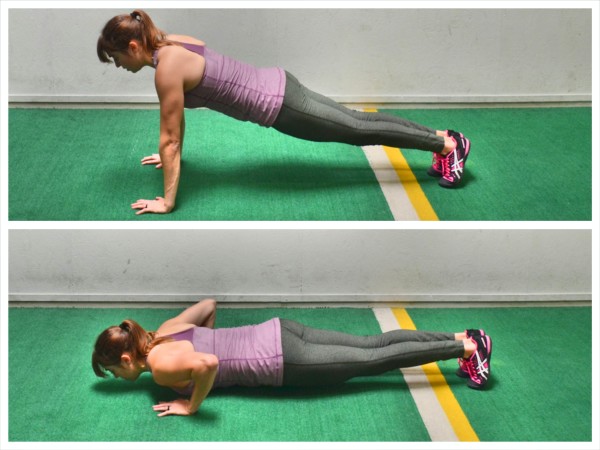
To do the Basic Push Up, set up in the high plank position with your hands under your shoulders and your arms locked out while your feet are together and your body is in a nice straight line from your head to your heels. Make sure you can drive back through your heels and that your feet aren’t too far back so that you are up on your toes.
Squeeze your glutes and legs together as you brace your abs and drive back through your heels to engage your legs (especially your quads). You want to make sure to squeeze your legs together to help hold your body in a nice straight line. By squeezing your legs together, your adductors will engage.
By engaging your core before you even lower, your hips shouldn’t drop toward the ground and your butt shouldn’t go up in the air toward the ceiling as you perform the Push Up. By engaging your core before you do the Push Up, you will help your body move as one unit. Make sure that as you set up, your head isn’t tucked toward the ground or jutting forward. Your back should also not be excessively arched or rounded.
Your body should be in a nice straight line with your core engaged.
While in the high plank position, remember your hands should be below your shoulders and right outside your chest. Your finger tips should be pointing straight ahead and your hands should be pressing into the ground and away from each other as if trying to tear a piece of paper between them. You can play around with exact hand with to place more emphasis on different muscles.
As you lower down to do the Push Up, you should lower your chest directly between your hands, keeping a nice straight line with your body. Your elbows shouldn’t flare out from your body. Your elbows should make an arrow shape with your body. Like this (–> ). You do not want your arms to create a “T” with your body or you will put more strain on your shoulders and risk injury. You also don’t need to keep your arms right in by your sides unless you want to work more tricep.
Your shoulders, elbows and wrists should all be in a straight line as you lower. Your body should move as one unit toward the ground.
Touch your chest to the ground when you lower with everything moving together. Hips shouldn’t move back up first or touch the ground first. Your head also shouldn’t jut forward as you lower and lift.
Everything should move as one without your hips sagging or your elbows flaring out as you lower or lift. Keep your head in line with your spine.
Only if you engage your entire core will your body move as one unit down to the ground and back up.
Once you touch your chest to the ground, press back up to the starting position and lock out your arms and then repeat, lowering your chest back down to the ground as you keep your body in a nice straight line.
The Basic Parallel Bar Dip:
While you can do Dips off a bench, the Dip Variation that is a compound pushing exercise like the Push Up is the Parallel Bar Dip.
The Parallel Bar Dip is a great vertical pushing exercise to work the upper body and core. And like the Push Up, the Parallel Bar Dip is a great functional bodyweight exercise to include in your workout routine.
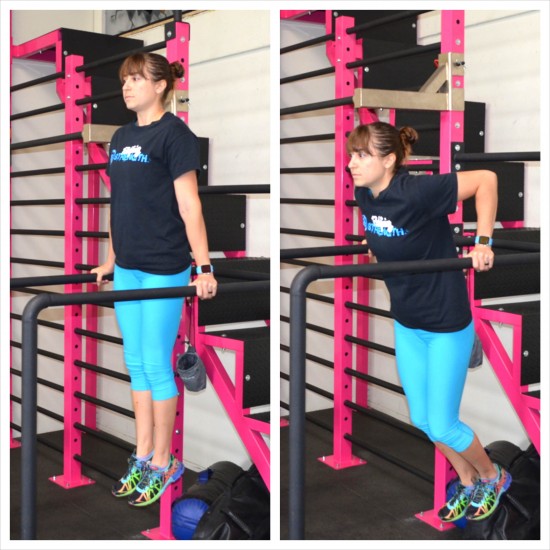
To do the Basic Parallel Bar Dip, place a hand on each bar and grip the bar tightly.
Jump or press up so that your weight is held by your arms and your arms are fully extended with your chest pressed out and your shoulders down. Do not shrug your shoulders as you hold at the top of the dip. You can keep your legs down straight or bend your knees. When you do Dips, you can lean forward a bit to target your chest more or you can stay more upright to focus on your triceps more.
From the top of the dip, slowly bend your elbows and lower your body down toward the ground. You want to lower yourself down until your upper arms are about parallel to the ground.
Then drive back up through your hands until you are fully extended at the top. Keep your core tight and squeeze your glutes as you press up so you don’t arch your low back. Also, try to keep your head in line with your spine as you dip and press.
Once you’ve locked your arms out at the top of the dip, lower back down and repeat.
Again, you can stay more upright to work more tricep or lean forward a bit more to work the chest.
Comparing Push Ups and Dips
Push Ups and Dips both need to be included in your workout routine as they help you work your upper body from different angles and target the muscles of your chest, shoulders and triceps in different ways.
They work the muscles from different angles because Dips are a vertical press while Push Ups are a horizontal press.
Both can also be varied to target your chest or your triceps more depending on your body and hand positioning during the movement.
However, Dips, in general, require more shoulder mobility than Push Ups do.
While you want your shoulders to be in good health for Push Ups, or any pressing movement for that matter, Dips do require more shoulder mobility than Push Ups do and can be “harder” on the shoulders.
That can make Dips an exercise to avoid if you have poor thoracic extension or shoulder mobility even if you don’t currently have any pain or injuries.
This doesn’t mean that you should deem Dips dangerous and skip them all together. It simply means you should work on shoulder mobility and health and be careful and aware when including Dips.
Shoulder health and thoracic extension and even chest and lat flexibility are all important things to work on for any pressing exercise especially if you sit all day at a computer.
It is also important to be aware that when you choose to include Push Ups or Dips, or even both in your routine, that there is a huge difference between Dips Off A Bench and Parallel Bar Dips and even different Push Up Variations.
Dips Off A Bench Vs. Parallel Bar Dips
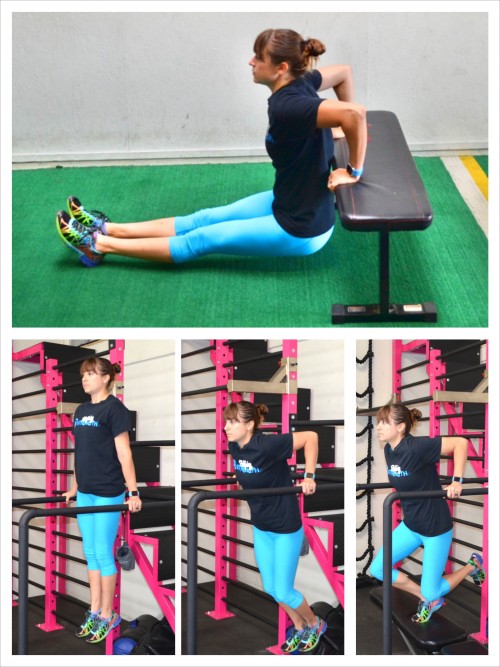
Dips in general can be tougher on the shoulders. This doesn’t mean that you should exclude them from your workouts. It does, however, mean that you should work on improving your upper body mobility, flexibility and even activation of the bigger muscle groups if you plan to include Dips.
For foam rolling, stretch and activation moves to improve your shoulder health, check out these 10 Tips and Exercises.
It is also important to note that Dips Off A Bench are generally harder on the shoulders than Parallel Bar Dips. And while we often use Dips Off A Bench as a regression for full Parallel Bar Dips, they may not be the best option to regress the movement, just like Knee Push Ups aren’t necessarily the best option to regress the full Push Up.
Dips Off A Bench can be a great way to target your triceps and should be included every once in a while as long as you also keep your shoulder healthy, but unlike Parallel Bar Dips, Dips Off A Bench do not target your chest at all or even your core.
Dips Off A Bench are not the big compound exercise working your chest, shoulder, triceps and core that Parallel Bar Dips are. They are a much more isolated movement focusing really on the triceps and front part of your shoulders.
So what do you d0 if you can’t do Full Parallel Bar Dips, but want to still work your chest and core in the same way with a vertical press?
You do either Foot-Assisted or Eccentric Focused/Only Parallel Bar Dips.
Foot-Assisted Parallel Bar Dips:
A great way to regress the Full Parallel Bar Dip is by using your feet for assistance. This way you are still performing a vertical press and still working your core and upper body, but your upper body doesn’t have to handle your full weight until you are ready.
It also teaches your body to work and engage in the same way it has to for the Full Parallel Bar Dip unlike Dips Off A Bench which are basically a completely different movement.
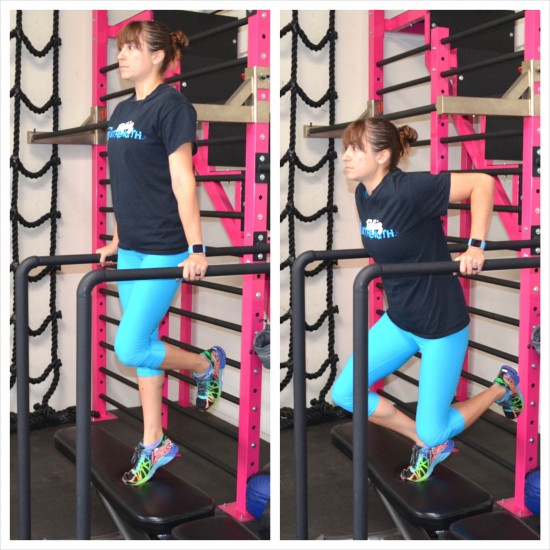
To do Foot-Assisted Parallel Bar Dips, set up on Parallel or Dip Bars that are close enough to the ground that you can keep your toes on the ground even when pressed to the top of the Dip. If you need to, place a box under you so that you can use your feet to help you press up.
Then keeping your toes on the ground, or even one foot on the ground, press up to the top of the dip. Extend your arms fully and keep your chest pressed out. Do not shrug your shoulders at the top of the Dip.
Slowly lower yourself down until your arms are bent to about 90 degrees. Keep your toes on the ground to take a little weight off your upper body, but make sure you are still forcing your upper body to work.
You do not want to turn this into a lower body move.
Keep your core tight as you lower.
Then press back up, using your feet to assist you as much as you need. Again, do not turn this move into a lower body exercise. Force your upper body to work to press up.
Just like with the full Parallel Bar Dip, you can lean forward a bit to work your chest more or stay more upright to work your triceps more.
Move in a slow and controlled fashion up and down. Try to use your feet as little as possible.
You can make the foot-assisted variation more challenging by not only consciously using your feet less, but by also only putting one foot down to help you.
You can also only use your feet to help you press up or help you control the lower down.
For instance, you could use your feet and do a Jumping Dip where you only use your feet to help you get back up to the top and then take on your full weight to lower down.
But only do this Jumping Variation if you can slow down and control the decent.
The Jumping Variation is also a great way to do the Eccentric-Focused or Eccentric-Only Dip Variation.
Eccentric-Only or Eccentric-Focused Dip:
The Eccentric-Only or Eccentric-Focused Dip is a great way to improve your Dips because you are taking on your full weight and slowing down a portion of the lift to spend more time under tension.
For either Eccentric Dip Variation, what you will do is slow down the Eccentric portion of the Dip – aka you will slow down the lower down.
If you can’t yet do a full Parallel Bar Dip, this is a great way for you to start taking on your entire bodyweight for at least a portion of the lift.
Even if you can do full Dips, an Eccentric-Focused Dip can help you build even more strength and take your Dips to the next level!

To do an Eccentric-Only Dip, you can either do a Foot-Assisted or Jumping Dip to set up at the top of the Dip. This Dip Variation is for those who can’t yet do the Dip so are only going to be taking on their full bodyweight for the lower down.
Once set at the top of the Dip, lift your feet and slowly lower yourself down to the bottom of the Dip. Perform at least a 3-5 count lower down.
Then jump or use your feet to reset back at the top.
Repeat, lowering slowly. If you can’t lower slowly any longer, stop and rest. Do not keep doing reps with a quick lower down.
Like with all full Parallel Bar Dips, you can lean forward to get your chest more or stay more upright to focus on your triceps.
If you can’t yet take on your full weight to lower down, you can do a Foot-Assisted Eccentric-Focused Dip and keep your feet down the entire time while slowing down the lower down.
To do an Eccentric-Focused Dip, you will perform a full Parallel Bar Dip and simply slow down the lower down. This is an advanced move and should only be attempted once you can complete full Dips.
Pick an assisted variation that works for you. And remember, you can always use Dips Off A Bench to work your triceps and shoulders, just remember they won’t work your core or chest in the same way that full Parallel Bar Dip Variations will and that those Dips Off A Bench may be even harder on your shoulders.
The Differences Between Push Up Variations
Just like with Dips, different Push Up Variations, aka different hand placements and body positions, will target the muscles of your upper body and core in different ways.
The nice thing about Push Ups too is that you need no equipment and can easily do them anywhere, unlike Dips that do require at least bars or a bench.
There are also more Push Up Variations than Dip Variations out there to work your upper body and core from different angles and focus on different aspects of the same basic muscles.
Some basic Push Up Variations are:
- Narrow Grip, Close Grip or Diamond
- Wide Grip
- Staggered Grip
- Incline Push Ups
- Eccentric-Focused/Eccentric-Only
Incline Push Ups can be done with any of the grips (narrow, wide, staggered), but are a way to regress the Basic Push Up while still working and engaging your core in the same way you would from the ground.
Incline Push Ups, because they work your body in the same way, may be a better regression than the Knee Push Up if you have access to an appropriate incline height.
Incline Push Ups:
Incline Push Ups are a great way to build up not only your upper body strength, but also your core strength, for full Push Ups.
Because you are on your feet, your body is forced to engage everything in the same way it would for full Push Ups; however, because your hands are up on an incline, you do not have to handle your entire weight. As you become stronger, you can lower the incline until you can handle your whole bodyweight from the ground.
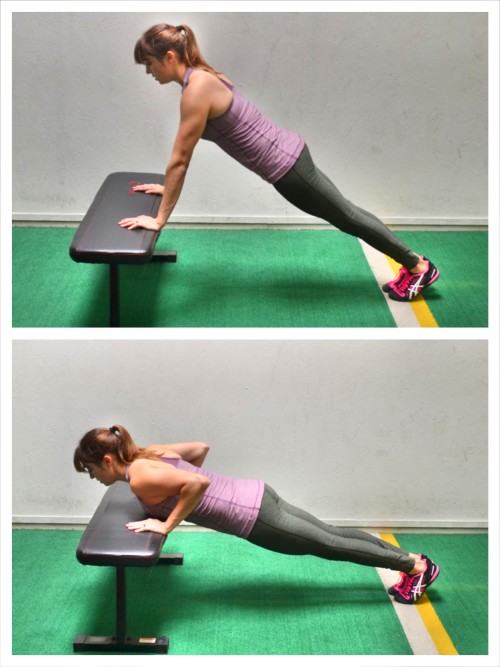
To do Incline Push Ups, find an incline that allows you to perform Push Ups with perfect form. It may have to be higher to start, but you can use anything really – a wall, bench, shelf or bar at an appropriate height that allows you to drop your chest all the way down while maintaining perfect form.
With your hands on the incline, place your feet together and your hands right outside your chest. You may want to set up at the bottom of the push up so that you know your chest will hit the incline right at nipple height between your hands. By setting up at the bottom of the Push Up, you can ensure that your upper body will be in perfect alignment with your arms forming an arrow shape (->) with your body. You do not need to keep your arms right in by your sides unless you are performing a Narrow Grip Push Up; however, you don’t want your elbows to flare up above your shoulders or you will put more strain on your shoulders.
Drive back through your heels to engage your quads as you brace your core and keep your body in a nice straight line. If you press forward onto your toes, you are going to make your push ups weaker because your legs won’t be engaged to help keep your body in a nice straight line.
Then press up from the bar, extending your arms out all the way and locking out at the top. Do not round your back at the top.
As you press up, make sure your body moves as one unit. Your head should be in line with your spine and your hips shouldn’t sag toward the ground or your butt shouldn’t go up in the air.
Make sure your shoulders don’t shrug as you push up. You also don’t want your back to round at the top of the push up. Do not tuck your chin in toward your chest or let your head jut forward.
Then with your body moving as one unit, lower your chest back down to the bar.
As you perform the movement, if your feet are together, you may even feel your inner thighs working to help keep everything tight and in a nice straight line.
Even at the bottom of the push up, do not relax. Keep everything engaged so you can press right back up.
As the incline becomes easier, make it lower and lower. If your form starts to falter, do fewer reps from the lower incline or regress the incline and bring it back up.
With Incline Push Ups, just like with full Push Ups, you can change your grip to target different aspects of your upper body and core.
You can also do an Eccentric Variation just like with Dips.
Eccentric-Focused or Eccentric-Only Push Ups:
With any variation of the Push Up, you can slow down the Eccentric portion, aka the lower down toward the ground, of the move.
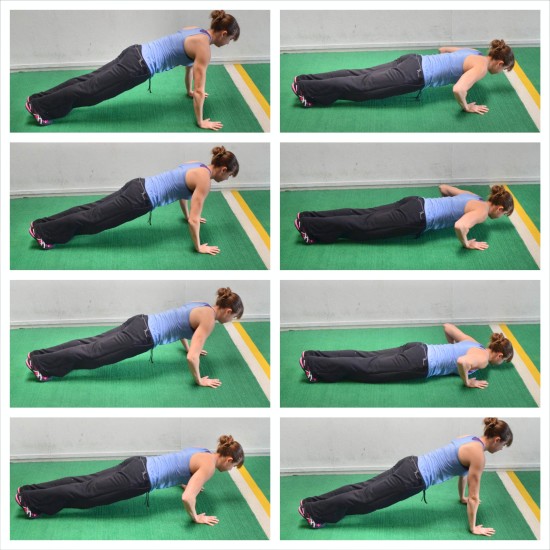
You can do an Eccentric-Focused Incline Push Up, Knee Push Up or Full-Push Up. For any of these variations, you will simply Push Up to the top of the Push Up variation and then slow down the lower down for at least a 3-5 count. Touch the ground and then push back up with perfect form.
To make the Eccentric-Focused Push Up even harder, release at the bottom and then push back up from a dead stop.
You can also utilize the Eccentric-Only Push Up to help you take your Push Ups to the next level if you aren’t yet able to do a harder variation, but feel the easier variation becoming just a little too easy.
By doing an Eccentric-Only Push Up, you are forcing yourself to take on your full bodyweight for only a portion of the movement, which may allow you to do a harder variation and force your body to engage and work properly during that harder variation.
For instance, if you aren’t yet able to do full Push Ups from the ground, but are close, you can use the Eccentric-Only Push Up to help you get there. The Eccentric-Only variation will force your body to work in the same way it will have to for the full Push Ups, but will make it easier because you can just reset at the top.
To do Eccentric-Only Push Ups, you can do them from an incline, your knees or your toes. You want to pick the most advanced variation you can, but still make sure that you can maintain proper form. This is a time to pick a harder variation than you do when you are doing reps where you have to push back up to the top.
Using whichever variation you choose, set up at the top. You do not need to perform a Push Up to set up. Then slowly lower down for a 3-5 count, keeping your body in a nice straight line. Drop all the way down to the ground.
Here you can release and relax onto the ground and then reset. You do not need to push back up. Simply reset at the top.
Your focus is on perfect form for a very slow lower down. At the bottom you can release and simply reset back at the top.
This Eccentric-Only or even Eccentric-Focused Push Up can be used with with the standard grip or even with the Narrow, Wide or Staggered Grips.
Narrow-Grip, Close-Grip or Diamond Push Ups:
Narrow-Grip Push Ups are a great Push Up Variation to target your triceps more while still working your upper body and core, including your glutes, quads and adductors.
To do the Narrow-Grip Vairation, you can set up so your hands are just outside your chest with your arms staying in by your body or you can set up with your hands making a Diamond shape if you want to make the move even more challenging.
The closer your hands are together, the harder the move will be and the more your triceps will be forced to work. Below is the Diamond Push Up (top) and the Narrow or Close Grip Push Up (bottom).

To do Narrow-Grip Push Up, place your hands no wider than right outside your chest as you set up in the high plank position with your feet together and your body in a nice straight line. The closer your hands are together (aka the closer to a Diamond Push Up you get), the harder the move will be and the more your triceps will be forced to work.
Then keeping your body in a nice straight line, lower your chest down to the ground. Your body should move as one unit to lower down without your butt going up in the air or your hips sagging. Also, make sure to keep your elbows and arms in by your side as you lower. Do not let them flare out at all or you will not force your triceps to work as hard.
Lower your chest as close to the ground as possible then press back up. Make sure your body moves as one unit and your arms don’t flare out. Often with Narrow-Grip Push Ups, people will start to press back up and end up arching their backs because their hips stay down and their triceps aren’t strong enough.
If you can’t press back up with your core staying engaged and your body in a nice straight line, you may need to regress the movement to an Incline Narrow-Grip Push Up or a Knee Narrow-Grip Push Up.
Once you’ve pressed back up, repeat, lowering down with your arms in by your sides.
To make the move more challenging, perform a Diamond Push Up.
To do the Diamond Push Up, place your first fingers and thumbs together to create a diamond with your hands. You want your hands to be under your chest as you lower to the ground. With this move, your elbows can flare out a bit from your body, but the more they stay in, the harder the move will be.
With your hands in the diamond and your body in a nice straight line, lower your chest down to your hands and then press back up. Make sure to engage your entire core and keep your head in line with your spine as you lower and press back up.
Do not allow yourself to do the “worm” and push back up to the top in pieces. Everything should work together as you force your triceps to work harder.
Wide-Grip Push Ups:
While Narrow-Grip Push Ups work your triceps more, Wide-Grip Push Ups isolate your chest a bit more. Often Wide-Grip Push Ups are the easiest Push Up Variation for people to do.
However, you do have to make sure that your hands don’t get too far out in front of you or you will place more strain on the shoulders.
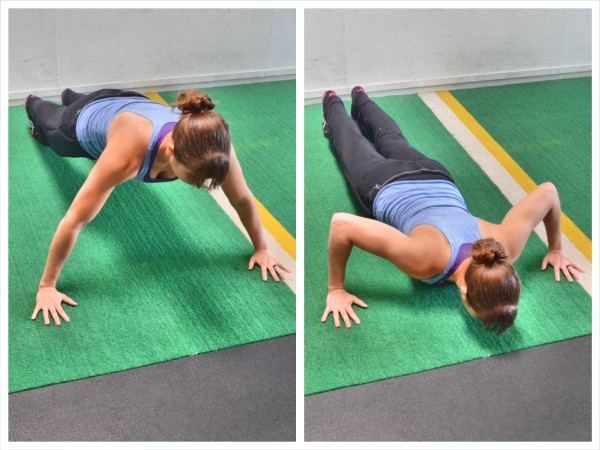
To do Wide-Grip Push Ups, you can set up on an incline, from your knees or from your toes on the ground. To find a good width for your hands, make your hands into fists and then place your knuckles together with your hands and arms on the ground. Where your elbows are with your knuckles together and arms out to the sides is where you should put your hands for the Push Ups.

Make sure your hands are at chest height and not way out in front of you. Then set up in the high plank position with your feet close together and your body in a nice straight line from your head to your heels.
To do the Wide-Grip Push Up, lower your chest down to the ground, keeping your body in a nice straight line. Do not let your hips sag or your butt go up in the air.
Once you’ve lowered all the way down, press back up with your body moving as one unit. Lock your arms out at the top and repeat, lowering back down.
Make sure that you are pressing your hands straight down into the ground and not rocking toward the outside of your palms as you perform the Push Up.
Staggered Grip Push Ups:
With the Staggered Grip Push Up, you can work your shoulders and triceps, targeting different muscles on each side. Make sure to switch your stance and do reps with your hands staggered both ways.

To do the Staggered Stance Push Up, you will stagger one hand up higher than the other and allow one elbow to flare out as you keep the other arm in by your side. Place one hand up at about shoulder height or just slightly higher with your fingertips pointing in. Place the other hand just outside your chest with your fingertips pointing straight ahead. Set up with your arms locked out and your feet close together. Your body should be in a nice straight line from your head to your heels. Make sure you aren’t shrugging your shoulders as you set up.
Keeping your legs engaged and core tight, lower your body down toward the ground as one unit. As you lower down, your arm with the fingertips turned in may flare out as you keep the other arm in by your side. Try to touch your chest to the ground without your hips sagging or your butt going up in the air. Do not tuck your chin as you lower down. Keep your hands flat on the ground as you lower and lift.
Lower down then press back up to the top, moving your body as one unit. Complete all reps on one side then stagger your hands the other way.
If turning the top hand in creates too much strain on your shoulder and engages your upper trap, you can keep both hands pointing straight ahead with one outside your chest and the other up right at the top of your shoulder (shown in bottom three photos).
Which Is Best – Push Up or Dip?
While you need to include both Push Ups and Dips in your workout routine, and both truly have their benefits, the question is, “Is one more important to include than the other?”
And our opinion is – Push Ups are better.
While we definitely include Dips in our workout routines, Push Ups are a staple included in some way, shape or form in every progression while Dips are not included every time.
The reason we deem Push Ups “better” is because there are so many different variations that people of all ages and levels can do to target their chest, shoulders, triceps and core in different ways.
And they aren’t as hard on your shoulders as Dips, which makes them better for the average person who sits hunched over a computer screen for 9 hours a day. This hunched over position leads to poor shoulder mobility and poor thoracic extension, which makes Dips more risky.
Also, Push Ups can more easily be done ANYWHERE.
Which is your favorite exercise – The Push Up or the Dip? And what variations of the Dip and Push Up do you include?
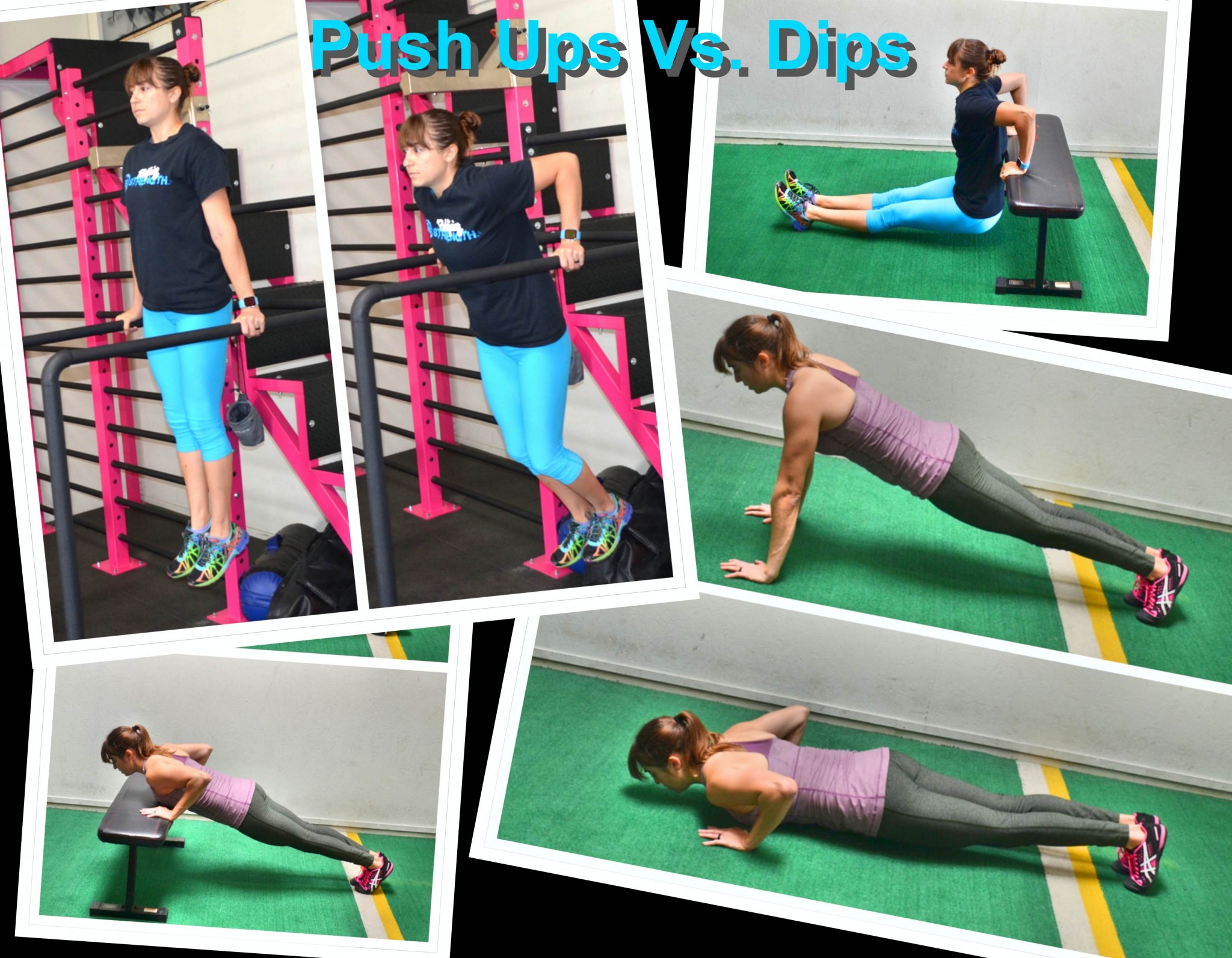


0 Comments
Trackbacks/Pingbacks